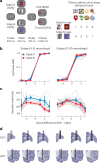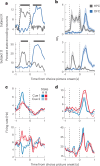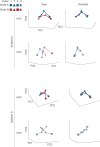Context-dependent decision-making in the primate hippocampal-prefrontal circuit
- PMID: 39762657
- PMCID: PMC11802454
- DOI: 10.1038/s41593-024-01839-5
Context-dependent decision-making in the primate hippocampal-prefrontal circuit
Abstract
What is good in one scenario may be bad in another. Despite the ubiquity of such contextual reasoning in everyday choice, how the brain flexibly uses different valuation schemes across contexts remains unknown. We addressed this question by monitoring neural activity from the hippocampus (HPC) and orbitofrontal cortex (OFC) of two monkeys performing a state-dependent choice task. We found that HPC neurons encoded state information as it became available and then, at the time of choice, relayed this information to the OFC via theta synchronization. During choice, the OFC represented value in a state-dependent manner; many OFC neurons uniquely coded for value in only one state but not the other. This suggests a functional dissociation whereby the HPC encodes contextual information that is broadcast to the OFC via theta synchronization to select a state-appropriate value subcircuit, thereby allowing for contextual reasoning in value-based choice.
© 2025. The Author(s).
Conflict of interest statement
Competing interests: The authors declare no competing interests.
Figures






References
-
- O’Keefe, J. & Nadel, L. The Hippocampus as a Cognitive Map (Oxford Univ. Press, 1978).
-
- Behrens, T. E. J. et al. What is a cognitive map? Organizing knowledge for flexible behavior. Neuron100, 490–509 (2018). - PubMed
-
- Whittington, J. C. R., McCaffary, D., Bakermans, J. J. W. & Behrens, T. E. J. How to build a cognitive map. Nat. Neurosci.25, 1257–1272 (2022). - PubMed
MeSH terms
Grants and funding
- R01 MH117763/MH/NIMH NIH HHS/United States
- R01-MH117763/U.S. Department of Health & Human Services | NIH | National Institute of Mental Health (NIMH)
- R01-MH121448/U.S. Department of Health & Human Services | NIH | National Institute on Minority Health and Health Disparities (NIMHD)
- R01 MH121448/MH/NIMH NIH HHS/United States
- R01 MH131624/MH/NIMH NIH HHS/United States
LinkOut - more resources
Full Text Sources
Research Materials

